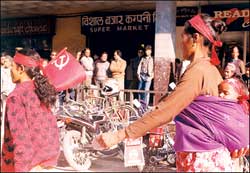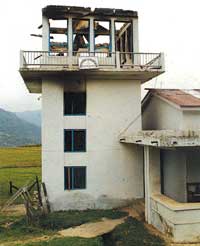 Encouraged by a ceasefire that has held for six weeks, the government says it is preparing a blueprint for reconstruction and rehabilitation in insurgency-affected areas to present to donors next week.
Encouraged by a ceasefire that has held for six weeks, the government says it is preparing a blueprint for reconstruction and rehabilitation in insurgency-affected areas to present to donors next week.
Aside from the human cost of the seven-year conflict and the setback to development due to lost opportunities, the country has suffered an estimated Rs 4 billion worth of damage to infrastructure. Not only do we have to rebuild, but we also need to catch up with lost time to deliver basic services to large sections of the country.
Donor representatives in Kathmandu are more than willing to fund rehabilitation and reconstruction work, but say they want a viable strategy and the political will to see it through.
After the state of emergency in November 2001, the rebels started attacking "soft targets" including bridges, hydropower plants and telecommunication towers. Not even milk depots, post offices, schools, health posts, and VDC buildings were spared. The Maoist leadership later seemed to realise that it had made a mistake, and ordered cadre not to target infrastructure directly benefiting the people. But the damage was already done.
The Maoists rampage has destroyed 1,675 of the 4,000 VDC buildings in the country. "We don't even know what the full damage to public property is in monetary terms," Ganga Dutta Awasthi, joint secretary at the Ministry of Local Development told us. But the ministry has asked for local surveys of loss so reconstruction funds can be released.
Foreign donors already provide nearly two-thirds of Nepal's total development expenditure. "We believe the peace process will be strengthened if some of the humanitarian and human rights issues are tackled," says Norwegian ambassador, Ingrid Ofstad. The Finance Ministry and National Planning Commission (NPC) are busy preparing for a meeting of Kathmandu-based donor representatives next week.
"We want to provide a peace dividend, and want to prioritise people who are most-badly affected by the insurgency with labour-intensive income generating welfare activities," says NPC vice-chairman Shanker Sharma.
"Of course, we will mobilise our own resources but that will not be sufficient," adds Sharma. "So, we are working out the estimated shortfall and will be requesting development partners to chip in."
Nepal's donors have already started making their own assessment of how much help may be needed and where. The United Nations with aid agencies from Norway and Germany have been discussing plans to rehabilitate people displaced from their villages, and to immediately revive their "Food For Work" programs.
Danish charge d'affaires Gert Meinecke has just returned from Achham and Jumla after inspecting damage caused to the district headquarters in Maoist raids last year. Meinecke's field trip comes amid growing interest among the Europeans to support the peace process and rehabilitation.
Multilateral agencies like the World Bank and the Asian Development Bank have also said they will support specific government projects for reconstruction and rehabilitation. A meeting of Nepal Donor Group last month immediately after the ceasefire announcement discussed this issue and gave it top priority.
However, there is still concern in some quarters about the fragility of the peace process with particular worry about the continued lack of involvement of the political parties. Many also think that more than rehabilitation, the government in Kathmandu needs to make up for the neglect of development due to mal-governance in the past six years. "In most parts of the country there hasn't been any construction, so it doesn't make any sense to talk about reconstruction," says one Nepali staffer at a donor agency. Even so, many agree that restoring the development process and launching an urgent rehabilitation drive will help enforce the peace process and perhaps even make it irreversible.
India used to be a major donor to Nepal till the 80s, and its embassy in Kathmandu promises full support for the government's reconstruction plans. "There are on-going discussions between His Majesty's Government and the Indian government for taking up suitable projects," Minister for Economic Affaires at the Indian Embassy, Javed Osmani, told us. "Right now, we are discussing projects related to education, health and irrigation sectors and will also be assisting projects in insurgency-affected areas, as per the request of the Nepal government."
The United States and Britain have been in the news for high-profile military support for the Royal Nepal Army. They, too, have pledged increased funds for development. Speaking in Washington last week, Deputy Assistant Secretary of State Donald Camp said that the US government would provide over $70 million in aid this year in addition to $14 million military assistance for fiscal year 2002. (See page Nation).
Britain last week appointed Sir Jeffery James as its special representative to Nepal to coordinate international efforts to restore peace. James arrives in Kathmandu 16 March and will be visiting the mid-western districts to assess Nepal's needs in a post-conflict scenario.
The donor community had been urging consolidated efforts from within the country to turn the ceasefire into permanent peace, and open dialogue between the monarch and parliamentary parties. But the continued political mess isn't helping matters. Donors are most worried about the vacuum at the village and district levels after the dissolution of local elected bodies. They have urgently called for local elections to be held so that local leaders can guide the peace dividend.
"We think that putting in place a committee comprising all sides having interests in reconstruction and rehabilitation at the district level would help," David Wood, of the British aid agency DfID told us, adding that there was an urgent need, particularly in the mid-west and far-west, for food and for cash in the form of employment. "We are interested in providing support to programs which would do all of these things and do them quickly because the peace process can't wait for things to happen now," Wood added.
However, the government still lacks the institutional and political mechanism to move faster, even for the urgently required humanitarian relief. As thousands of people who had left their villages over the last few months gradually return to their villages in western Nepal, a massive humanitarian assistance package needs to be launched immediately.
"People are still scared to go to villages and are worried that they don't have any means to support themselves," said Prakash Jwala, former UML MP from Salyan who returned to the capital this week after touring his constituency. "There is a need to provide immediate relief to the affected people and engage them in income generating activities which could also help in the reconstruction of the destroyed infrastructure."
UN agencies are said to be interested in coordinating the reconstruction and rehabilitation programs, but are waiting for an exact assessment of the damage, a concrete blueprint for aid and a projection for the required funding. But time is running out, they say, and how fast the relief moves may also determine the direction of the peace process.

The Bhojpur tower, among nine airports attacked by the Maoists.

A bombed out VDC building in Rukum.


